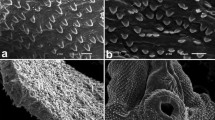Abstract
Our objective was to determine by scanning electron microscopy the structural changes in the tegument of adult Fasciola hepatica after treatment with 5-chloro-2-methylthio-6-(1-naphtyloxy)-1H-benzimidazole, called compound alpha, and its active metabolite sulphoxide, under in vitro and in vivo conditions. For the in vitro studies, flukes from sheep were exposed to 40 mg/l of compound alpha-sulphoxide over different incubation times. Flukes for the in vivo studies were raised in sheep treated orally with compound alpha and killed at different times post-treatment. Non-treated controls were included for each time of incubation. The results showed lesions after 6 h of treatment, such as swelling and furrows. At 12 h, the spines appeared to be surrounded by the tegument. At 24 h the tegument in some areas showed an exposed basal lamina. These changes became more severe as the incubation periods of the treated flukes increased. Compound alpha exerts a significant effect on the tegument of F. hepatica.

Similar content being viewed by others
References
Anderson HR, Fairweather I (1998) Fasciola hepatica: scanning electron microscopic evaluation of juvenile flukes following treatment in vitro with deacetyllated (amine) metabolite of diamphenethide (damd). Int J Parasitol 18:827–837
Bennett JL, Kohler P (1987) Fasciola hepatica: action in vitro of triclabendazole on immature and adult stages. Exp Parasitol 63:49–57
Buchanan JF, Fairweather I, Brennan GP, Trudget A, Hoey EM (2002) Fasciola hepatica: surface and tegumental changes induced by treatment in vitro with the sulphoxide metabolite of albendazole (valbazen). Parasitology 126:141–153
Dalton JP (1999) Fasciolosis. University Press, New York
Del Campillo C, Vázquez R (1999) Parasitología veterinaria. McGraw-Hill Interamericana, Madrid
Fairweather I, Boray JC (1999) Fasciolicides: efficacy, actions, resistance and its management. Vet J 158:81–112
Fairweather I, Anderson HR, Baldwin TMA (1987) Fasciola hepatica: tegumental surface alteratins following treatment in vitro with the deacetylated (amine) metabolite of diamphenethide. Parasitol Res 73:99–106
Hernández A, Ibarra F, Vera Y, Rivera N, Castillo R (2002) Synthesis and fasciolicidal activity of 5-chloro-2 methilthio-6(1-naphtyloxy)-1H-benzimidazole. Chem Pharm Bull 50:649–652
Ibarra VF, Jenkins DC (1984) An in vitro screen for new fasciolicidal agents. Z Parasitenkd 70:655–661
Ibarra VF, Vera MY, Hernández CA, Castillo BR (1996) Eficacia de un compuesto experimental contra Fasciola hepatica juvenil y adulta en ganado ovino. Vet Méx 27:119–122
Ibarra VF, García SE, Vera MY, Hernández CA, Castillo BR (1997) Eficacia fasciolicida del compuesto alfa contra estadios juveniles y adultos en ovinos. Vet Méx 28:4–8
Ibarra VF, Vera MY, Montenegro CN, Flores CJ, Hernández CA, Castillo BR (2000) Evaluación de cuatro vehículos para formular un fasciolicida experimental. Vet Méx 31:47–51
Ibarra F, Vera Y, Quiroz H, Cantó J, Castillo R, Hernández A, Ochoa P (2004). Determination of the effective dose of an experimental fasciolicide in naturally and experimentally infected cattle. Vet Parasitol 12:65–74
Meaney M, Fairweather I, Brennan GP, Ramasamy P, Subramanian PB (2002) Fasciola gigantica: tegumental surface alterations following treatment in vitro with the sulphoxide metabolite of triclabendazole. Parasitol Res 88:315–325
Meaney M, Fairweather I, Brennan GP, McDowell LSL, Forbes AB (2003) Fasciola hepatica: effects of the fasciolicide clorsulon in vitro and in vivo on the tegumental surface, and a comparison of the effects on young and old mature flukes. Parasitol Res 91:238–250
Meaney M, Fairweather I, Brennan GP, Forbes AB (2004) Transmission electron microscope study of the ultrastructural changes induced in the tegument and gut of Fasciola hepatica following in vivo drug treatment with clorsulon. Parasitol Res 92:232–241
Ministry of Agriculture Fisheries and Food (1988) Manual of veterinary parasitological laboratory techniques, 3rd edn. Ministry of Agriculture Fisheries and Food, London
Rivera N, Ibarra F, Olazarán S, Vera Y, Castillo R, Hernandez A (2002) Efficacy of 5-chloro-2 methylthio-6-(1-naphtyloxy)-1H-benzimidazole against different stages of Fasciola hepatica in pelibuey sheep. Vet Méx 33:55–61
Stitt AW, Fairweather I (1993) Fasciola hepatica: the effect of microtubule inhibitors colchicine and tubulozole-C on the structure of the adult fluke. Parasitology 107:297–309
Stitt AW, Fairweather I (1994) The effect of the sulphoxide metabolite of triclabendazole (Fasinex) on the tegument of mature and immature stages of the liver fluke, Fasciola hepatica. Parasitology 108:555–567
Vera MY (1994) Comparación de la eficacia e impacto inmunológico de 2 fasciolicidas contra F. hepatica en borregos pelibuey infectados experimentalmente. Masters thesis, National Autonomous University of Mexico, Mexico City
Vera MY, Ibarra VF, Quiroz RH, Hernández CA, Castillo R (2003) Field trial on the efficacy of an experimental fasciolicide compared with some commercial compounds in naturally infected cattle. Parasitol Res 91:1-4
Vera MY, Ibarra VF, Liebano WE, Quiroz RH, Castillo BR, Hernandez CA, Ochoa GP (2004) Efficacy of an experimental fasciolicide against immature and mature Fasciola hepatica in artificially infected calves. Parasitol Res 92:211–214
Acknowledgements
The authors thank Francisco Pasos Nájera for his technical assistance. This study was supported by the project PAPIIT-DEGAPA-UNAM No IN214502–3. It study complies with the current laws of Mexico.
Author information
Authors and Affiliations
Corresponding author
Rights and permissions
About this article
Cite this article
Rivera, N., Ibarra, F., Zepeda, A. et al. Tegumental surface changes in adult Fasciola hepatica following treatment in vitro and in vivo with an experimental fasciolicide. Parasitol Res 93, 283–286 (2004). https://doi.org/10.1007/s00436-004-1127-3
Received:
Accepted:
Published:
Issue Date:
DOI: https://doi.org/10.1007/s00436-004-1127-3




